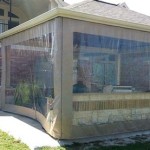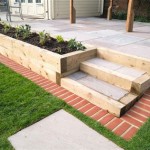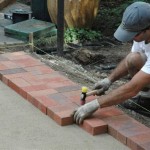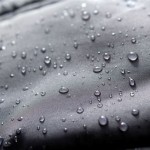Resurfacing a Cement Patio: A Comprehensive Guide
A cement patio, while durable, can eventually succumb to the effects of weather, wear, and time. Cracks, stains, and general surface degradation can make the space less inviting and aesthetically pleasing. Resurfacing a cement patio offers a cost-effective alternative to complete replacement, restoring its functionality and appearance. This article will provide a comprehensive guide to the process, detailing the necessary steps, techniques, and materials required for a successful resurfacing project.
Assessing the Damage and Determining Suitability
Before embarking on a resurfacing project, a thorough assessment of the existing patio is crucial. The extent and nature of the damage will dictate the appropriate resurfacing method and materials. Consider the following factors:
Crack Severity:
Hairline cracks are typically superficial and can be easily addressed with resurfacing compounds. However, wider and deeper cracks, especially those indicating structural problems with the patio's foundation, may necessitate more extensive repairs before resurfacing. Major structural issues might even render resurfacing an unsuitable option, making complete replacement a more viable solution.Surface Condition:
Examine the patio for signs of scaling, spalling (flaking), and pitting. Minor surface imperfections can be covered with a thin resurfacing layer. However, severe surface deterioration might require a thicker overlay or even concrete grinding to achieve a sound base for the new surface.Drainage:
Poor drainage can contribute to moisture buildup and accelerated deterioration of the patio surface. Address any drainage issues before resurfacing to prevent future problems. This may involve adjusting the patio's slope, installing drainage channels, or improving the surrounding landscaping.Previous Treatments:
If the patio has been previously sealed or coated, ensure the existing coating is compatible with the intended resurfacing material. Incompatible coatings can lead to adhesion problems and premature failure of the new surface. Removal of the old coating may be necessary.Once the assessment is complete, a determination can be made regarding the feasibility and appropriate approach for resurfacing. If the patio exhibits significant structural damage or pervasive deterioration, consulting with a professional concrete contractor is highly recommended.
Preparation: The Key to a Lasting Resurface
Proper preparation is paramount to the success of any resurfacing project. Thoroughly cleaning and preparing the existing concrete surface ensures optimal adhesion and prevents future failures. The following steps outline the essential preparation procedures:
Cleaning:
Begin by removing all furniture, planters, and other items from the patio. Use a stiff-bristled brush and a concrete cleaner to scrub the surface, removing dirt, debris, algae, and mildew. Power washing can be an efficient way to clean large areas, but exercise caution to avoid damaging the concrete. Allow the patio to dry completely before proceeding.Crack Repair:
Address any cracks in the concrete surface. For hairline cracks, a concrete crack filler specifically designed for hairline cracks can be used. For wider cracks, use a concrete patching compound or epoxy crack filler. Follow the manufacturer's instructions carefully, ensuring that the filler is properly mixed and applied. Allow the filler to cure completely before proceeding to the next step.Surface Profiling (Etching or Grinding):
Creating a rough surface profile is crucial for ensuring proper adhesion of the resurfacing material. This can be achieved through acid etching or concrete grinding. Acid etching involves applying a diluted solution of muriatic acid to the concrete surface. Follow safety precautions carefully, wearing protective clothing, gloves, and eye protection. After etching, thoroughly rinse the surface with water and allow it to dry completely. Concrete grinding involves using a concrete grinder with a diamond grinding wheel to remove the top layer of concrete and create a rough surface. This method is more effective for removing stubborn stains or coatings and creating a more uniform profile.Masking and Protection:
Protect surrounding areas, such as walls, landscaping, and doors, with masking tape and plastic sheeting. This will prevent the resurfacing material from staining or damaging these areas.Priming (Optional):
Applying a concrete primer can further enhance adhesion and improve the bond between the existing concrete and the resurfacing material. Choose a primer that is compatible with the specific resurfacing material being used. Follow the manufacturer's instructions for application and drying time.Once these preparation steps are completed, the patio is ready for the application of the resurfacing material.
Selecting and Applying the Resurfacing Material
A variety of resurfacing materials are available, each offering different properties and aesthetic qualities. The choice of material will depend on the desired look, budget, and the specific requirements of the project. Common options include:
Concrete Overlay:
Concrete overlays are thin layers of modified concrete that are applied over the existing concrete surface. They can be applied in a variety of textures and patterns, offering a wide range of design possibilities. Some overlays are self-leveling, creating a smooth, even surface, while others can be stamped or stenciled to create decorative patterns.Polymer-Modified Concrete:
Polymer-modified concrete is a type of concrete overlay that incorporates polymers to improve its strength, durability, and adhesion. These overlays are highly resistant to cracking and spalling, making them a good choice for areas with heavy foot traffic or exposure to harsh weather conditions.Epoxy Coatings:
Epoxy coatings are durable and chemical-resistant coatings that can be applied to concrete surfaces to create a seamless, glossy finish. They are available in a wide range of colors and can be used to create decorative patterns or designs. However, epoxy coatings can be slippery when wet, so it is important to choose a non-slip additive for patio applications.Acrylic Coatings:
Acrylic coatings are water-based coatings that are easy to apply and provide good weather resistance. They are available in a variety of colors and can be used to create textured finishes. However, acrylic coatings are not as durable as epoxy coatings and may require more frequent reapplication.Application Techniques:
Follow the manufacturer's instructions carefully when applying the chosen resurfacing material. Typically, the material is mixed according to the manufacturer's specifications and then applied to the prepared concrete surface using a trowel, squeegee, or sprayer. Ensure the material is evenly distributed and properly bonded to the existing concrete. For stamped or stenciled finishes, specialized tools and techniques are required.Curing:
Proper curing is essential for ensuring the strength and durability of the resurfaced patio. Follow the manufacturer's instructions for curing time and methods. Typically, the surface is kept damp for several days to allow the concrete to properly hydrate and harden. This can be achieved by covering the surface with plastic sheeting or applying a curing compound.Finishing Touches and Maintenance
Once the resurfacing material has cured, several finishing touches can enhance the appearance and longevity of the patio.
Sealing:
Applying a concrete sealer is highly recommended to protect the resurfaced patio from stains, water damage, and UV degradation. Choose a sealer that is compatible with the specific resurfacing material used. Apply the sealer according to the manufacturer's instructions, ensuring that the surface is clean and dry before application.Caulking:
Caulk any expansion joints or control joints in the patio to prevent water from seeping underneath the resurfacing material. Use a flexible, weather-resistant caulk that is specifically designed for concrete surfaces.Regular Cleaning:
Regularly clean the patio to remove dirt, debris, and stains. Use a mild detergent and a stiff-bristled brush to scrub the surface. Avoid using harsh chemicals or abrasive cleaners, as these can damage the sealer and the resurfacing material.Periodic Inspection:
Periodically inspect the patio for cracks, chips, or other signs of damage. Address any issues promptly to prevent further deterioration. Reapply sealer as needed to maintain protection.By following these guidelines and taking proper care of the resurfaced patio, its beauty and functionality can be enjoyed for many years to come.

3 Concrete Resurfacing Options For Patio

Resurfacing A Concrete Patio For Budget Diy Makeover Fab Everyday

Why Concrete Patio Resurfacing Is Better Than Replacement Creative Solutions

How To Resurface A Concrete Patio With Decorative Overlay

3 Concrete Resurfacing Options For Patio

5 Ways To Upgrade Your Concrete Patio

How To Fix Resurface Damaged Concrete Sidewalk Diy

Concrete Resurfacing Stoneset

Concrete Resurfacing Projects And Supplies Intermountain

How To Repair Concrete Patios Resurfacing Sealing Resin
Related Posts








